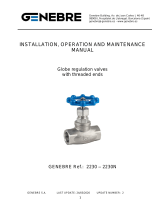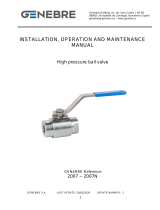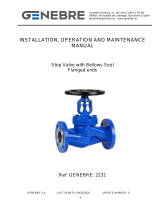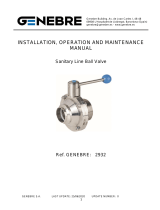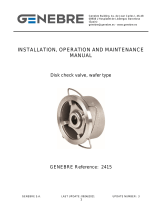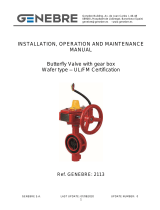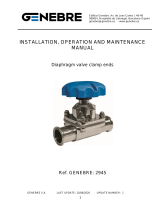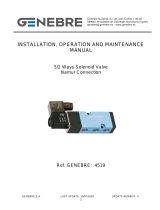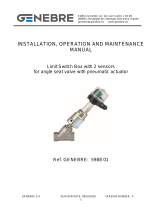Page is loading ...

Genebre Building. Av. de Joan Carles I, 46-48
08908 L'Hospitalet de Llobregat. Barcelona (Spain)
genebre@genebre.es - www.genebre.es
GENEBRE S.A.
LAST UPDATE: 24/01/2023 UPDATE NUMBER: 2
1
INSTALLATION, OPERATION AND MAINTENANCE
MANUAL
Pressure Reducing Valve
with threaded/flanged ends
Ref. GENEBRE: 2274 – 2274N – 2275

Genebre Building. Av. de Joan Carles I, 46-48
08908 L'Hospitalet de Llobregat. Barcelona (Spain)
genebre@genebre.es - www.genebre.es
GENEBRE S.A.
LAST UPDATE: 24/01/2023 UPDATE NUMBER: 2
2
INSTRUCTIONS FOR INSTALLATION, OPERATION & MAINTENANCE MANUAL
1. Product description ....................................................................... 3
2. Transport and Storage conditions …………….................................... 3
3. Exploded view ......................................................................................... 4
4. Installation Instructions
4.1 Preparation …………………............................................................... 6
4.2 Assembling ……………….………………………………………... 6
4.3 Commissioning ……………….……………………………………. 7
5. Operating Instructions
5.1 Usage ................................................................................................... 7
5.2 Instructions for regulation ..................................................................... 8
5.3 Capacity Chart ..………………….……………………………….. 8
6. Maintenance Instructions ...................................................................... 9
6.1 Overhaul of the Pilot Valve Strainer .................................................. 10
6.2 Replacement of the Regulating Spring .................................................. 10
6.3 Replacement of the Pilot Valve ………................................................... 10
6.4 Overhaul of the Main Strainer, Disc and Seat ....................................... 11
6.5 Overhaul of the Main Diaphragms ….................................................... 11
6.6 Spare Parts Codes ………………….................................................. 12
7. Hygiene and Safety Instructions ........................................................... 12

Genebre Building. Av. de Joan Carles I, 46-48
08908 L'Hospitalet de Llobregat. Barcelona (Spain)
genebre@genebre.es - www.genebre.es
GENEBRE S.A.
LAST UPDATE: 24/01/2023 UPDATE NUMBER: 2
3
1. Product description.
Genebre, S.A. offers a wide range of valves designed and assembled to handwheel and
drive fluids in industrial procedures.
The compatibility of materials used to build the valves (see technical specifications) and the
application of valves to the different industrial processes is at user's risk. Valves will have an
optimal behavior when working conditions do not exceed pressure and temperature limits
(pressure curve) for which they have been designed.
Art. 2274: Pressure Reducing Valve with threads according to ISO 7-1 (EN 10226-1).
Art. 2274N: Pressure Reducing Valve with threads according to ASME B1.20.1 NPT
Art. 2275: Pressure Reducing Valve with flanges according to EN 1092-1 PN25
2. Transport and Storage conditions
Transport and storage of this kind of products must be done keeping them in their
original package!
VISUAL INSPECTION
Check whether during transport, unloading and placement the products have suffered
damages.
During storage it is recommended to keep them into the included protective wrapping to
avoid damages or dirt accumulation in the inside part of the valve. The wrap must not be
removed until valve is to be installed.
Valves must be stored in a dry and clean environment.
If you notice any kind of anomaly during reception of the goods, contact immediately
with GENEBRE in order to determine the possible responsibilities on the issue.
IMPORTANT NOTE:
Before installing and/or manipulating these elements, READ CAREFULLY these
instructions for use and OBSERVE all contained information. If you fail to
understand any of their content, please contact GENEBRE, S.A.
User is responsible for the safe use of these products, according to present
instructions for use and specific technical documentation of the device.

Genebre Building. Av. de Joan Carles I, 46-48
08908 L'Hospitalet de Llobregat. Barcelona (Spain)
genebre@genebre.es - www.genebre.es
GENEBRE S.A.
LAST UPDATE: 24/01/2023 UPDATE NUMBER: 2
4
3) Exploded view

Genebre Building. Av. de Joan Carles I, 46-48
08908 L'Hospitalet de Llobregat. Barcelona (Spain)
genebre@genebre.es - www.genebre.es
GENEBRE S.A.
LAST UPDATE: 24/01/2023 UPDATE NUMBER: 2
5
Nº
Denominación / Name
Material
Acabado Superf.
Finishing Surface
Treatment
Recambios
Spare Parts
1
Tornillo Regulación /
Regulating Bolt
Acero al Carbono / Carbon Steel
Pavonado / Blued
------
2
Tuerca / Nut
Acero al Carbono / Carbon Steel
Pavonado / Blued
------
3
Tapa superior / Upper cover
Acero Fundido / Cast Steel 1.0619 (WCB)
Pintado / Painted
------
4
Tuerca / Nut
Acero al Carbono / Carbon Steel
Pintado / Painted
------
5
Guía Muelle / Spring Guide
Acero Inox / Stainless Steel 2Cr13
------
------
6
Regulating Spring /
Muelle Regulación
Acero / Steel 50CrVA
------
M2274
7
Pletina Muelle / Spring Pad
ZCuAl10Fe3
------
------
8
Diafragma / Diaphragm
Acero Inox / SS 12Cr17Ni7
HRC 52-56
DR2274
9
Válvula Piloto / Pilot Valve
Acero Inox / Stainless Steel 2Cr13
------
VP2274
10
Cámara Válvula Piloto /
Pilot Valve Chamber
Acero Fundido / Cast Steel 1.0619 (WCB)
------
------
11
Filtro Válvula Piloto /
Pilot Valve Strainer
Acero Inox / Stainless Steel
1Cr18Ni9Ti
------
FR2274
12
Tapón / Plug
Acero Inox / Stainless Steel 2Cr13
------
------
13
Espárrago / Stud
Acero al Carbono / Carbon Steel
Pintado / Painted
------
14
Muelle Principal /
Main Valve Spring
Acero / Steel 50CrVA
------
K2274
15
Disco / Disc
Acero Inox / Stainless Steel 2Cr13
------
K2274
16
Asiento / Seat
Acero Inox / Stainless Steel 2Cr13
------
K2274
17
Tuberias Control / Control Pipes
Acero Inox / Stainless Steel AISI 304
------
------
18
Tuberías Equilibrio / Balancing Pipes
Acero Inox / Stainless Steel AISI 304
------
------
19
Filtro Principal / Main Strainer
Acero Inox / SS 1Cr18Ni9Ti
------
FP2274
20
Junta Cuerpo / Gasket
Inoxidable + Grafito / SS+ Graphite
------
JC2274
K2274
FP2274
21
Cuerpo / Body
Acero Fundido / Cast Steel 1.0619 (WCB)
Pintado / Painted
------
22
Casquillo / Bushing
Acero Inox / SS 2Cr13
------
------
23
Junta Cuerpo / Gasket
Inoxidable + Grafito / SS + Graphite
------
JC2274
K2274
FP2274
24
Espárrago / Stud
Acero al Carbono / Carbon Steel
Pintado / Painted
------
25
Tuerca / Nut
Acero al Carbono / Carbon Steel
Pintado / Painted
------
26
Tornillo / Bolt
Acero al Carbono / Carbon Steel
Pintado / Painted
------
27
Tapa superior diafragma /
Diaphragm upper cover
Acero Fundido / Cast Steel 1.0619 (WCB)
Pintado / Painted
------
28
Eje / Stem
Acero Inox / SS 2Cr13
------
------
29
Tuerca / Nut
Acero al Carbono / Carbon Steel
Pintado / Painted
------
30
Plato diafragma / Diaph Tray
Acero Inox / SS 2Cr13
------
------
31
Diafragma princ. / Main diaphragm
Acero Inox / SS 12Cr17Ni7
HRC 52-56
DP2274
32
Tapa inferior diafragma /
Diaphragm under cover
Acero Fundido / Cast Steel 1.0619 (WCB)
Pintado / Painted
------
33
Tuerca Nut
Acero al Carbono / Carbon Steel
Pintado / Painted
------

Genebre Building. Av. de Joan Carles I, 46-48
08908 L'Hospitalet de Llobregat. Barcelona (Spain)
genebre@genebre.es - www.genebre.es
GENEBRE S.A.
LAST UPDATE: 24/01/2023 UPDATE NUMBER: 2
6
4. Installation instructions
4.1) Preparation
Remove any material remains of the valve wrapping.
Serious problems may arise with the installation of a valve in a dirty pipe.
Make sure the pipe is not dirty and doesn’t have welding particles, for example, before
installing it. This may cause irreparable damages in the valve when the equipment is started
→ prepare a clean working area.
Plan beforehand enough space for future maintenance operations.
4.2) Assembling
Art. 2274 / 2274N: Make sure that the pipe and the valve thread are clean and also that they
are compatible with each other (thread standard). Apply an appropriate sealant to the pipe
threads and screw in the valve, being careful not to overtighten the tapered threads. To
tighten the valve to the pipe, the use of a fixed wrench or spanner is recommended, applying
force only on the hexagonal area of the end. It is recommended that this applied force be less
than 30 N·m.
Art. 2275: Use gaskets between valve and pipe flanges to keep sealing. The valves are
designed for mounting between EN 1092 PN25 flanges. Check the good parallelism of the
flanges. Leave enough space between the two so that the valve can be easily inserted or
removed. Tighten the flange bolts to hold the valve firmly. Apply alternate tightening method
to ensure proper installation.
Design for this kind of valves allows only one position for assembling it to the
pipe, specified by means of an arrow in the valve's body that indicates the
direction in which the fluid needs to circulate.
The valve needs to be installed in a horizontal pipeline and with the main diaphragm at the
bottom.
Valves do not have to support pipe's efforts, so it is advisable to anticipate a good alignment
and parallelism of such pipe.
If a pressure reduction higher than 10 to 1 is required, the installation of two valves in series
can be considered. In this case, a sufficient distance must be left between them and improve
the drainage by means of interleaved steam traps.
It is strongly recommended the use of filters in the pipes (upstream) for proper
operation, as well as to prolong the life cycle of the pressure reducing valve. On the

Genebre Building. Av. de Joan Carles I, 46-48
08908 L'Hospitalet de Llobregat. Barcelona (Spain)
genebre@genebre.es - www.genebre.es
GENEBRE S.A.
LAST UPDATE: 24/01/2023 UPDATE NUMBER: 2
7
other hand, it is also recommended to install a pressure gauge and a shut-off valve
both upstream and downstream and isolate the valve by means of a ‘bypass’.
It is also necessary to install a safety valve at the valve outlet, in order to protect the
entire downstream installation, whose set pressure must keep a sufficient margin with
respect to the working pressure and thus allow the restart or blowdown of the safety
valve; otherwise, the valve will not close properly and will leak.
It is important that the length of straight pipe both upstream and downstream is at
least 10 times the diameter of the pipe.
4.3) Commissioning
1- Close the shut-off valves (upstream and downstream) and bypass the steam to clean
the condensate and dirt from the pipeline.
2- Open the shut-off valves of all the pressure gauges.
3- Using a wrench, turn the Regulating Bolt (part.1) counterclockwise to loosen the
Regulating Spring (part.6).
4- Open the downstream shut-off valve slightly and then slowly open the upstream shut-
off valve.
5- Now the valve is ready for adjustment or regulation (see section 5.2).
5. Operating instructions
5.1) Usage
Valve materials have to be fully compatible with the fluid circulating through the valve.
Otherwise, valve could be seriously damaged. These valves are specifically designed for
use with steam, air, or inert gases.
The main purpose of pressure reducing valves is to reduce the fluid pressure to optimum
operating values, constantly below the maximum permitted vales so as not to damage
installations after the reducing valve.
This valve has a high reduction capacity, the maximum ratio being approximately 10: 1. For
higher reductions use two valves in series (see section 4.2). The regulating spring that comes
from the factory is used for an outlet pressure range of 0.5 to 12 bar.

Genebre Building. Av. de Joan Carles I, 46-48
08908 L'Hospitalet de Llobregat. Barcelona (Spain)
genebre@genebre.es - www.genebre.es
GENEBRE S.A.
LAST UPDATE: 24/01/2023 UPDATE NUMBER: 2
8
5.2) Instructions for regulation
The pressure reducing valve is supplied at the minimum regulation pressure (0 or almost 0).
To increase the outlet pressure, follow the instructions below:
a. Prepare the installation as indicated in section 4.3) Commissioning.
b. Using a wrench, turn the Regulating Bolt (part.1) clockwise until the desired pressure
is reached.
c. Fully open the downstream shut-off valve and recheck the outlet pressure.
d. Rectify, if necessary, turning the Regulating Bolt.
5.3) Capacity Chart
Steam
Example: a valve size DN40 reducing from 10 bar (upstream) to 7 bar (downstream) is able
to flow until 2000 Kg/h of steam, approximately.

Genebre Building. Av. de Joan Carles I, 46-48
08908 L'Hospitalet de Llobregat. Barcelona (Spain)
genebre@genebre.es - www.genebre.es
GENEBRE S.A.
LAST UPDATE: 24/01/2023 UPDATE NUMBER: 2
9
Compressed Air
The previous diagrams show the discharge capacity of the pressure reducing valves of
GENEBRE, S.A. art. 2274 / 2274N / 2275, according to the relationship between the Inlet
Pressure (P1) and the Outlet Pressure (P2), for both steam and compressed air.
6. Maintenance instructions
Frequency, place and process of maintenance will be determined by the user by taking into
account usage of the product.
Before disassembling the pipe's valve to clean or replace it, make sure that line
has been closed and depressurized because a bad operational procedure could
cause a serious accident to staff and installation system

Genebre Building. Av. de Joan Carles I, 46-48
08908 L'Hospitalet de Llobregat. Barcelona (Spain)
genebre@genebre.es - www.genebre.es
GENEBRE S.A.
LAST UPDATE: 24/01/2023 UPDATE NUMBER: 2
10
6.1) Overhaul of the Pilot Valve Strainer (part.11)
a. Isolate the valve from fluid and pressure.
b. Loosen the Plug (part.12) and remove the Strainer (part.11).
c. Clean the Strainer under running water with a brush if necessary. Let dry.
d. Put the Strainer back in its housing and tighten the Plug firmly with PTFE tape on the
thread to ensure tightness.
e. If necessary, replace the filter with a new one (see section 6.6).
6.2) Replacement of the Regulating Spring (part.6)
a. It is not necessary to isolate the valve from the rest of the installation.
b. Release the pressure of the Regulating spring by turning the Regulating Bolt (part.1)
counterclockwise.
c. Remove the 4 nuts (part.4) using a wrench and remove the Upper Cover (part.3) and
the Spring Guides (part.5).
d. Replace the Spring (part.6) with another that is suitable for the required regulation
pressure. Use only original GENEBRE, S.A. spare parts (see section 6.6).
e. Reassemble in reverse process.
6.3) Replacement of the Pilot Valve (part.9)
The pilot valve is the element in charge of modulating the control pressure and transmitting it
to the main diaphragm (part.31), which in turn is in charge of regulating the fluid pressure. It
is made up of several components. After intensive use, it could become damaged and stop
regulating properly, so it should be replaced with a new set. Next, the replacement of the
Pilot Valve is explained step by step:
a. Isolate the valve from fluid and pressure.
b. Release the pressure of the Regulating Spring by turning the Regulating Bolt
(part.1) counterclockwise.
c. Remove the 4 nuts (part.4) using a wrench and remove the Upper Cover (part.3),
the Spring (part.6), the two Guides (part.5) and the two Diaphragms (part.8).

Genebre Building. Av. de Joan Carles I, 46-48
08908 L'Hospitalet de Llobregat. Barcelona (Spain)
genebre@genebre.es - www.genebre.es
GENEBRE S.A.
LAST UPDATE: 24/01/2023 UPDATE NUMBER: 2
11
d. d. Unscrew the Pilot Valve assembly using a 19 mm spanner and replace with a
new one, tightening it to a torque of approximately 50 N · m.
e. Reassemble in reverse process, keeping in mind the cleanliness of all components.
f. The Diaphragms (part.8) must be mounted in the same position in which they were
removed. Apply liquid sealant (eg PTFE) on the outside on both sides. If not
available, wrap the entire perimeter of both diaphragms with PTFE tape on the
outside.
6.4) Overhaul of the Main Strainer (part.19), Disc (part.15) & Seat (part.16)
a. Isolate the valve from fluid and pressure.
b. Release the pressure of the adjustment spring by turning the Adjustment Screw
(part.30) counterclockwise.
c. Remove the 4 nuts (part.4) using a wrench and remove the Upper Cover (part.3),
the Spring (part.6) and the two Guides (part.5).
d. Loosen the upper nut of the Control and Balancing Pipes (part 17 and 18) in order
to extract the Chamber of the pilot valve (part 10) upwards.
e. Extract the Strainer (part 19) and clean it under running water with a brush. Let dry.
If necessary, replace with a new one (see section 6.6).
f. Remove the Gasket (part.20), the Spring (part.14), the Disc (part.15) and the Seat
(part.16).
g. Clean up any dirt you find on these parts. If the Disc or Seat are noticeably
scratched or worn, proceed with their replacement.
h. Replace the Gasket (part.20) with a new one.
i. Reassemble in reverse process, keeping in mind the cleanliness of all components.
j. When reassembling the Disc (part.15) and the Seat (part.16) you must take into
account the clearance that must remain between these two parts. See below:
Valve size
Disc lift
DN15-1/2”
2,5 mm
DN20-3/4”
2,5 mm
DN25-1”
3 mm
DN32-11/4”
3,5 mm
DN40-11/2”
4,5 mm
DN50-2”
5 mm

Genebre Building. Av. de Joan Carles I, 46-48
08908 L'Hospitalet de Llobregat. Barcelona (Spain)
genebre@genebre.es - www.genebre.es
GENEBRE S.A.
LAST UPDATE: 24/01/2023 UPDATE NUMBER: 2
12
k. Use a depth gauge to make the measurement easier.
l. Rectify, if necessary, the height of the Stem (part.28) by tightening or loosening the
Nut (part.29).
6.5) Overhaul of the Main Diaphragms (part.31)
a. Isolate the valve from fluid and pressure.
b. Invert the position of the valve (turning 180º) to facilitate its manipulation.
c. Unscrew the Bolts (part.26) and the Nuts (part.33) to remove the Diaphragm Under
Cover (part.32).
d. Clean thoroughly the inside of both Covers (part.27 and part.32).
e. Visually inspect both diaphragms. If any damage is observed, they must be
replaced with new units. In case of being reused, they must be mounted in the
same position in which they were removed. Apply liquid sealant (eg PTFE) on the
outside on both sides. If not available, wrap the entire perimeter of both
diaphragms with PTFE tape on the outside.
6.6) Spare Part Codes
XX = must indicate the size
It is advisable to carry out periodic maintenance of the valve (every 12-24 months
depending on the use) by means of a visual inspection of all the internal
components, replacing or cleaning according to the state in which they are found.

Genebre Building. Av. de Joan Carles I, 46-48
08908 L'Hospitalet de Llobregat. Barcelona (Spain)
genebre@genebre.es - www.genebre.es
GENEBRE S.A.
LAST UPDATE: 24/01/2023 UPDATE NUMBER: 2
13
7. Hygiene and Safety Instructions:
7.1) Fluids that go through a valve can be corrosive, toxic, flammable or pollutant. They can
also be found at very high or low temperature. When operating valves, you must follow the
security instructions and it is recommended to use personal protection gadgets:
1) Protect your eyes.
2) Wear gloves and appropriate working clothes.
3) Wear safety footwear.
4) Wear a helmet.
5) Have running water at hand.
6) To operate flammable fluids, make sure you have an extinguisher at hand.
Before removing a valve from a pipe, always check if the line is completely
drained and depressurized.
7.2) Always operate the valve in open position to make sure there is no pressure in the
internal cavity.
7.3) Any valve being used by toxic services department needs to obtain a cleanliness
certificate before being operated.
7.4) Any type of repair or maintenance should be performed in ventilated places.
/
